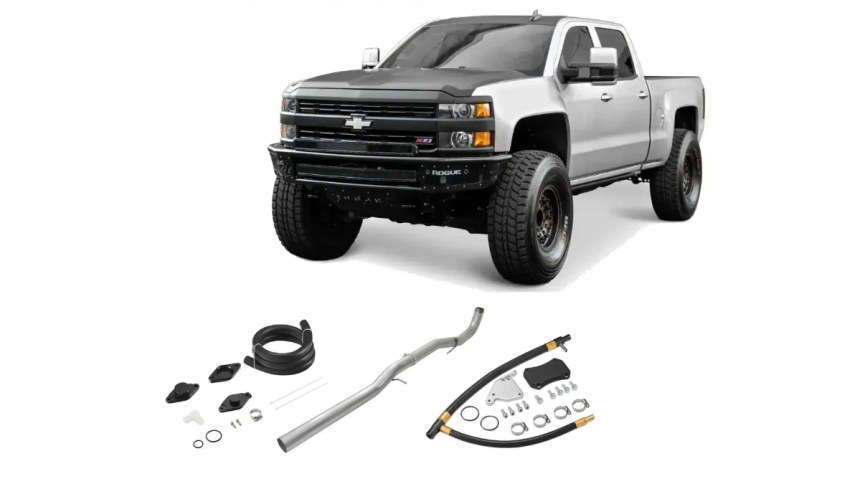Many diesel truck owners turn to aftermarket modifications such as DPF (Diesel Particulate Filter) delete kits and related delete kits to enhance vehicle performance, improve fuel efficiency, and reduce maintenance costs. This guide will delve into the specifics of DPF delete kits, their benefits, and legal implications. It will also provide a broader understanding of other delete kits commonly used to modify diesel engines.
Understanding DPF Delete Kits
What is a DPF Delete Kit?
A DPF delete kit is an aftermarket modification designed to remove or bypass the diesel particulate filter (DPF) in a vehicle’s exhaust system. The DPF is responsible for trapping and removing soot from diesel engine exhaust gases. A DPF delete kit typically includes components like a straight pipe to replace the DPF and electronic modules to bypass the vehicle’s DPF-related sensors and systems.
Benefits of a DPF Delete Kit
- Improved Performance: Removing the DPF reduces exhaust backpressure, allowing the engine to breathe more freely and produce more power.
- Enhanced Fuel Efficiency: Fuel efficiency can improve with reduced backpressure and the elimination of DPF regeneration cycles.
- Lower Maintenance Costs: Eliminating the DPF removes the need for costly repairs and maintenance associated with DPF failures and regenerations.
- Extended Engine Life: With less stress on the engine and fewer regeneration cycles, overall engine wear and tear are reduced.
- Elimination of Regeneration Issues: DPF regeneration can cause performance interruptions and increased fuel consumption. Deleting the DPF eradicates these issues.
Types of DPF Delete Kits
- Complete Delete Kits: These kits remove the DPF and include a replacement exhaust pipe and necessary tuning modules.
- Partial Delete Kits: These kits disable the DPF but may leave some components in place. They often require less extensive modifications.
- Electronic Bypass Kits: These kits include electronic modules that trick the engine control unit (ECU) into thinking the DPF is still operational. They are often paired with a straight pipe or other physical modifications.
Choosing the Right DPF Delete Kit
- Vehicle Compatibility: Ensure the delete kit is designed for your vehicle’s make, model, and year.
- Quality of Components: Opt for kits from reputable manufacturers that use high-quality materials to ensure durability and performance.
- Installation Complexity: Consider whether you can perform the installation yourself or if professional assistance is required.
- Legal Considerations: Be aware of local emissions regulations and the legal implications of removing the DPF.
Installation Tips for DPF Delete Kits
- Preparation: Gather all necessary tools and parts before beginning the installation. Review the instructions thoroughly.
- Safety First: Ensure the vehicle is securely lifted and stable. Wear appropriate safety gear.
- Remove the DPF: Carefully remove the DPF and related components, following the kit’s instructions.
- Install Replacement Pipe: Install the straight pipe or replacement component included in the kit, ensuring all connections are secure.
- Install Electronic Module: Connect the electronic bypass module to the vehicle’s ECU as directed.
- Check for Leaks: Start the engine and check for exhaust leaks around the new components.
- Reprogram the ECU: Some kits require reprogramming the ECU to function correctly without the DPF.
Understanding Delete Kits
What Are Delete Kits?
Delete kits encompass a range of aftermarket modifications designed to remove or turn off various emission control systems in a vehicle. These can include DPF deletes, EGR (Exhaust Gas Recirculation) deletes, and DEF (Diesel Exhaust Fluid) deletes. These modifications aim to enhance performance fuel efficiency and reduce maintenance costs.
Common Types of Delete Kits
EGR Delete Kits: Remove or bypass the EGR system, which recirculates exhaust gases back into the engine
Common Types of Delete Kits (continued)
DEF Delete Kits: Eliminate the need for diesel exhaust fluid by removing the DEF system, which is used to reduce NOx emissions.
Catalytic Converter Delete Kits: Remove the catalytic converter to reduce exhaust backpressure and increase performance.
SCR Delete Kits: Remove the Selective Catalytic Reduction (SCR) system, another emissions control system that reduces NOx emissions.
Benefits of Using Delete Kits
- Enhanced Performance: Delete kits can significantly improve engine power and response by removing restrictive emissions control devices.
- Improved Fuel Economy: Many emissions control systems can negatively impact fuel efficiency. Deleting these systems can result in better miles per gallon.
- Reduced Maintenance Costs: Emissions systems often require frequent maintenance and can be costly to repair. Delete kits eliminate these ongoing expenses.
- Simplified Engine Management: With fewer emissions systems, the engine management becomes simpler, reducing the likelihood of related issues.
Legal Considerations for Delete Kits
- Emissions Regulations: In many regions, removing or turning off emissions control devices is illegal and can result in significant fines.
- Inspection Compliance: Vehicles with delete kits may fail emissions testing, making driving on public roads in some areas illegal.
- Manufacturer Warranty: Installing delete kits can void your vehicle’s warranty.
- Environmental Impact: Removing emissions controls increases the ecological footprint of your vehicle by increasing pollutants.
Choosing the Right Delete Kit
- Vehicle Compatibility: Ensure the delete kit is designed for your vehicle’s make, model, and engine type.
- Quality and Reliability: Choose kits from reputable manufacturers that produce reliable and durable products.
- Professional Installation: Due to the complexity of some delete kits, professional installation may be recommended to ensure proper function and safety.
- Consider Long-Term Impact: Consider the long-term implications of using delete kits, including potential legal issues and environmental impacts.
Installation Tips for Delete Kits
General Installation Tips
- Gather Tools and Parts: Ensure you have all the necessary tools and parts before starting the installation process.
- Read Instructions Carefully: Review the installation manual provided with the kit to understand the steps involved.
- Work in a Safe Environment: Ensure your work area is well-ventilated and has appropriate safety gear.
- Follow the Manufacturer’s Steps: Adhere strictly to the manufacturer’s installation instructions to avoid any issues.
Specific Installation Steps for Common Delete Kits
EGR Delete Kit Installation
- Preparation: Disconnect the battery and allow the engine to cool.
- Remove EGR Components: Carefully remove the EGR valve, cooler, and related components.
- Install Block-Off Plates: Place the block-off plates or other components provided in the kit.
- Reprogram ECU: Some kits require reprogramming the engine control unit to operate correctly without the EGR system.
DEF Delete Kit Installation
- Disable DEF System: Use the electronic bypass module to turn off the DEF system.
- Remove DEF Tank: In some cases, you may need to remove the DEF tank and related components.
- Install Bypass Components: Install bypass components in the kit to ensure proper engine operation.
Catalytic Converter Delete Kit Installation
- Lift Vehicle Safely: Ensure the vehicle is securely lifted and stable.
- Remove Catalytic Converter: Cut or unbolt the catalytic converter from the exhaust system.
- Install Replacement Pipe: Attach the straight pipe or replacement component, ensuring all connections are secure and leak-free.
Post-Installation Steps
- Check for Leaks: Start the engine and inspect all connections for exhaust or fluid leaks.
- Monitor Performance: Test the vehicle to ensure it operates correctly and has no warning lights or performance issues.
- Regular Maintenance: Even with delete kits installed, regular maintenance is crucial to ensure your vehicle operates efficiently and reliably.
Conclusion
DPF delete kits and other delete kits can offer significant performance enhancements, fuel efficiency improvements, and reduced maintenance costs for diesel engines. However, they also come with legal and environmental considerations that must be considered. CarYou can decide whether these modifications suit your vehicle by selecting high-quality components, understanding the legal implications, and following proper installation procedures; before performing any delete modifications, consider local regulations and the potential impact on emissions testing, and consult a professional if you’re unsure about the installation process. By balancing performance benefits with responsible usage, you can enjoy the advantages of a modified diesel engine while minimizing potential downsides.
Lynn Martelli is an editor at Readability. She received her MFA in Creative Writing from Antioch University and has worked as an editor for over 10 years. Lynn has edited a wide variety of books, including fiction, non-fiction, memoirs, and more. In her free time, Lynn enjoys reading, writing, and spending time with her family and friends.















